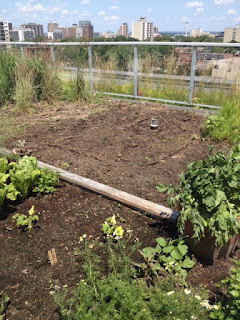Welcome to the Rooftop Gardening Community!
16 plots, a green space, and a patio! It is ours to enjoy and to take care of!
Personal Engagement
Everyone has different levels of engagement and that is how it should be! So long as you meet the minimum requirements of involvement which include tending your plot and helping to keep the wilderness weeded, you decide how involved you want to be.
The Minimalist just wants a quiet, solitary experience, tending their garden and being at peace. This member comes to the one mandatory meeting at the opening of the garden. He or she fulfills the minimum common area maintenance tasks.
The Newbie has never grown food before and maybe even kills houseplants. This gardener wants to experiment and learn about gardening by seeing what is happening in other gardens, asking questions of the garden coordinator or just other gardeners. He or she comes to meetings where the topics are of particular interest. He or she fulfills the minimum common area maintenance tasks.
The Socializer enjoys the balcony as an extension of his or her home. This member enjoys relaxing on the lawn chairs, reading, chatting, or having a picnic dinner by the plot. Notice how this person’s plot does so well, simply because it naturally gets seen to daily. The socializer is also a good conduit of information.
The Environmentalist is particularly interested in biodiversity and enjoys fostering plants that help each other and help the pollinators. This member is also interested in bee hotels, organic practices, and composting. The Environmentalist attends meetings of interest and brings us lots of interesting and useful information.
The Wild One and the Environmentalist have a lot in common. This gardener is interested in permaculture -- keeping lots of native plants and gently managing them in a natural organization.
The Artist enjoys creating beauty in the garden or writing for our blog. He or she comes to meetings of interest and often enjoys tending the flowers on the green roof wilderness.
The Compost Guru is completely smitten with the concept of composting and enjoys helping along the process of creating our own compost.
The Coordinator enjoys serving the group by facilitating the flow of information and finding answers to members’ questions. The Coordinator attends almost all of the meetings and makes sure there is a meeting lead when she is away. She communicates through one weekly email update and lots of blog posts.






